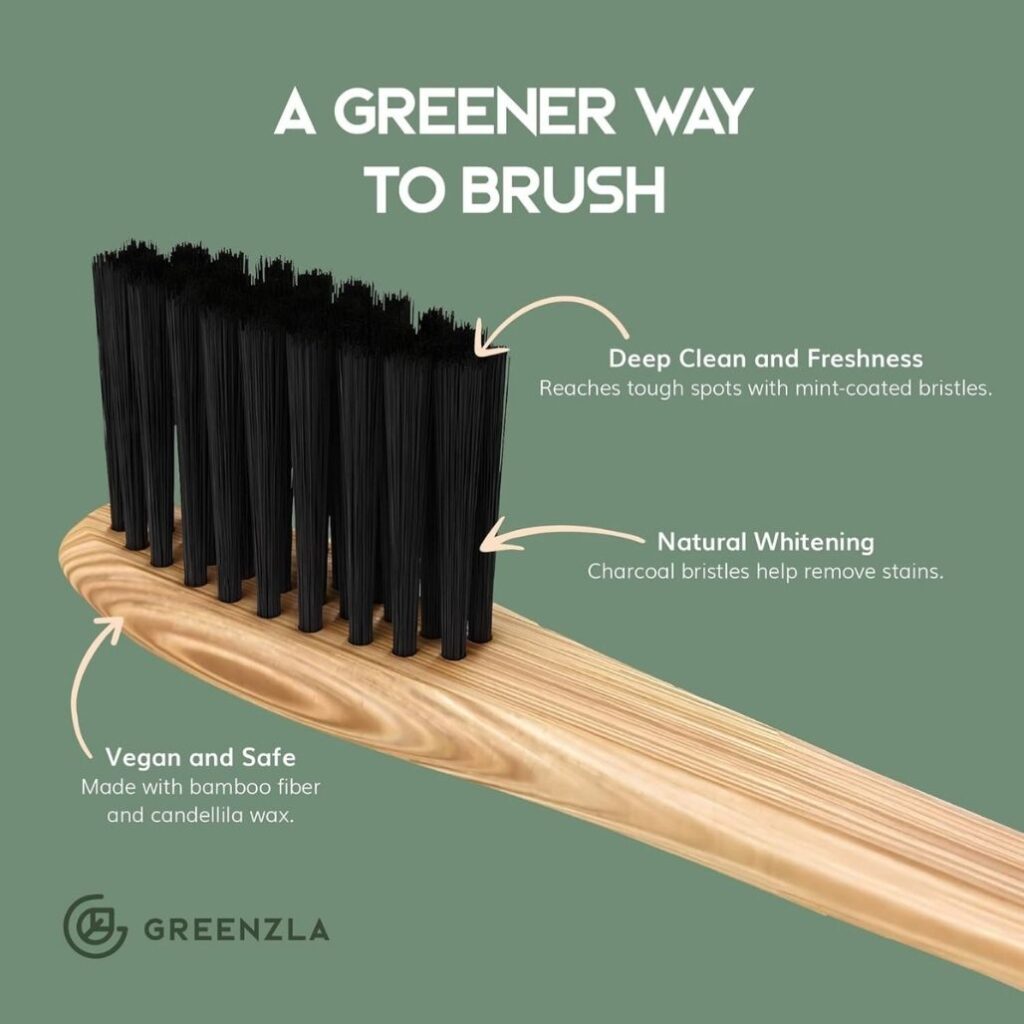The Best 11 Eco-Friendly Products
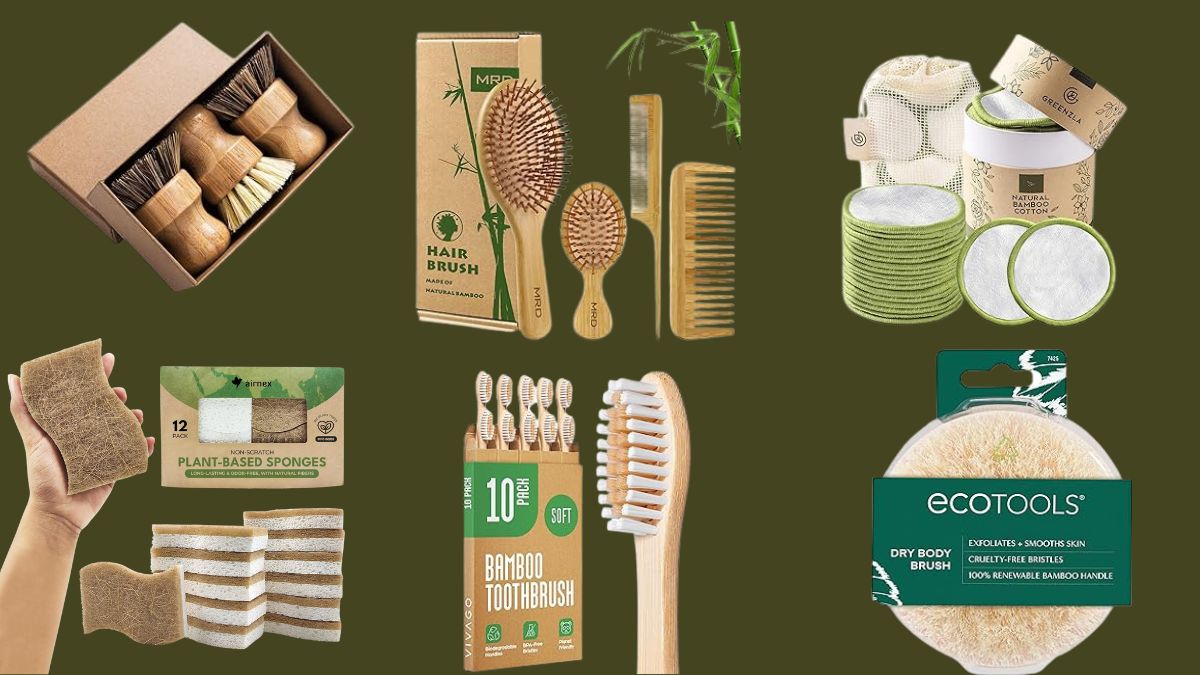
Introduction:
Today’s article is about Eco-Friendly Products. In a world increasingly conscious of the environmental impact of consumer products. Eco-friendly alternatives have gained popularity. These products are designed to reduce waste and energy consumption. and harmful emissions, contributing to a greener and more sustainable planet. In this article, we’ll explore the best 11 eco-friendly products. providing detailed product specifications, descriptions, pros, cons, and expert opinions to help you make informed choices.
Greenzla Bamboo Toothbrushes, Wooden Toothbrush Set with Soft Bristles, Includes Travel Case and Charcoal Dental Floss, 4 Pack


Organic Bamboo Toothbrushes. Our Greenzla adult bamboo toothbrushes are made from organic bamboo for a clean, eco-friendly brushing. Our wooden toothbrushes are a smart plastic free toothbrush choice for your tooth brush pack and bathroom essentials.
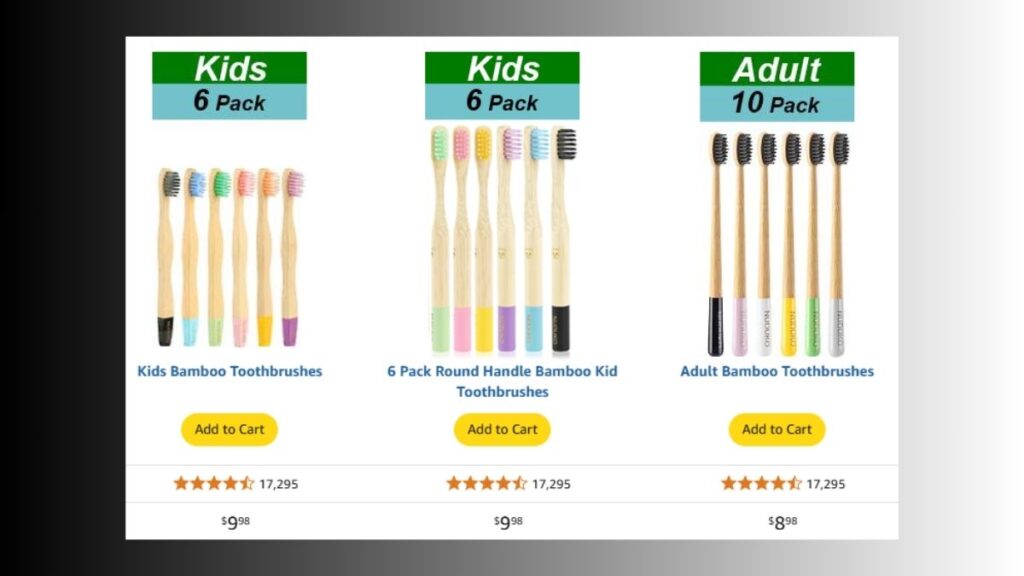
The details of The Best 11 Eco-Friendly Products are given below:
1. Reusable Stainless Steel Straws
Product Specification:
- Material: Food-grade stainless steel
- Length: Standard (8.5 inches) or extra-long (10.5 inches)
- Cleaning: Dishwasher safe
- The set includes: Straws, cleaning brushes, and a carry-case
Product Description:
Reusable stainless steel straws are a fantastic alternative to single-use plastic straws. They are durable, easy to clean, and come in various lengths and designs to suit your preferences. The included carry case makes it convenient to carry them on the go.
Pros:
- Reusable, reducing plastic waste
- Long-lasting and durable
- Dishwasher safe for easy cleaning
Cons:
- Some people dislike the metal taste
- Can get hot or cold to the touch, depending on the beverage
Expert Opinion:
“Stainless steel straws are a simple yet impactful switch to reduce plastic pollution. They are sturdy, easy to maintain, and make for a stylish addition to your eco-friendly toolkit.” – Sarah Green, Environmental Scientist
2. Beeswax Food Wraps
Product Specification:
- Material: Organic cotton infused with beeswax, resin, and jojoba oil
- Sizes: Various (small, medium, large)
- Reusability: Up to 12 months
- Cleaning: Hand wash with mild soap and cold water cleaning.
Product Description:
Beeswax food wraps are an eco-friendly alternative to plastic wraps. They’re made from organic materials and are reusable for up to a year. The warmth from your hands makes them malleable, allowing you to wrap food items of all shapes and sizes securely.
Pros:
- Reduces plastic use and waste
- Breathable and helps preserve food freshness
- Versatile and customizable
Cons:
- Not suitable for hot foods or microwaving
- May must regular re-waxing
Expert Opinion:
“Beeswax wraps are a sustainable way to keep your food fresh. while eliminating the need for disposable plastic wrap. They are also a great conversation starter to raise awareness about reducing plastic usage.” – Dr. Emily Green, Environmental Biologist

3. Solar-powered phone Charger
Product Specification:
- Charging capacity: Varies by model
- Charging ports: Many USB ports
- Battery: Lithium-polymer or lithium-ion
- Weight and size: Varies by model
Product Description:
A solar-powered phone charger harnesses the power of the sun to charge your devices. They are perfect for outdoor enthusiasts, and travelers. or anyone looking to reduce their reliance on traditional power sources. Some models even have built-in batteries for continuous charging at night.
Pros:
- Renewable energy source
- Ideal for camping and outdoor activities
- Emergency power source
Cons:
- Charging time can be slower on cloudy days
- The initial investment may be higher
Expert Opinion:
“Solar-powered phone chargers are a brilliant way to stay connected in remote areas while minimizing your carbon footprint. They are an essential tool for modern, eco-conscious adventurers.” – Dr. Robert Miller, Renewable Energy Specialist
4. Colgate Charcoal Bamboo Toothbrushes
Product Specification:
- Bristle material: Nylon-6 or bamboo charcoal-infused bristles
- Handle material: Sustainable bamboo
- Bristle options: Soft, medium, or firm
- Packaging: Compostable or recyclable
Product Description:
Colgate Charcoal Bamboo toothbrushes offer a sustainable alternative to traditional plastic toothbrushes. The bamboo handles are biodegradable, and some models feature eco-friendly bristles. These brushes come in various bristle options to suit your dental hygiene needs.
Pros:
- Biodegradable handle reduces plastic waste
- Natural, antibacterial properties of bamboo
- Many bristle options for user preference
Cons:
- Bristles may not be fully biodegradable
- The durability of bristles may vary
Expert Opinion:
“Bamboo toothbrushes are a small but significant step towards reducing plastic pollution. By making this simple switch, you can make a big contribution to a cleaner environment.” – Dr. Lisa Chen, Dentist and Environmental Advocate

Colgate Charcoal Bamboo toothbrushes
5. Eco-Friendly Products Laundry Detergent
Product Specification:
- Form: Liquid, powder, or pods
- Scent: Various options
- Packaging: Recyclable or biodegradable
- Special features: Hypoallergenic, plant-based, or free of harmful chemicals
Product Description:
Eco-friendly laundry detergents are designed to clean your clothes effectively. while minimizing their impact on the environment. They often use plant-based ingredients and avoid harsh chemicals. and come in sustainable packaging options.
Pros:
- Reduces water pollution and chemical exposure
- Gentle on sensitive skin
- Cruelty-free and ethical production
Cons:
- May be slightly more expensive than conventional detergents
- Some formulas might not perform as well on tough stains
Expert Opinion:
“Switching to eco-friendly laundry detergents is an easy way to protect both your family’s health and the environment. The long-term benefits outweigh any slight increase in cost.” – Emma White, Environmental Chemist

Eco-Friendly Laundry Detergent
6. LED Light Bulbs
Product Specification:
- Type: Various options (A19, BR30, etc.)
- Wattage: Varies by the model (typically 5-15W)
- Color temperature: Warm, cool, or daylight
- Lifespan: Up to 25,000 hours
Product Description:
LED (Light Emitting Diode) bulbs are energy-efficient lighting solutions. They consume less electricity than incandescent or fluorescent bulbs and have a longer lifespan. LED bulbs come in various shapes and sizes to fit different fixtures.
Pros:
- Energy-efficient, reducing electricity consumption
- Long lifespan saves money on replacements
- Instant-on and dimmable options
Cons:
- Higher initial cost compared to incandescent bulbs
- May not fit some specialty fixtures
Expert Opinion:
“LED bulbs are the future of lighting. They offer not only energy savings but also versatility and longevity. Making them an excellent choice for homeowners looking to reduce their carbon footprint.” – David Smith, Lighting Specialist
7. Reusable Shopping Bags
Product Specification:
- Material: Durable fabric (e.g., canvas, jute, or recycled plastics)
- Size: Varies (small, medium, large)
- Weight capacity: Typically 10-20 lbs
- Handles: Short or long, with or without reinforcement
Product Description:
Reusable shopping bags provide an environmentally responsible substitute for disposable plastic bags. They are sturdy, washable, and come in various sizes and designs. Many retailers offer discounts for bringing your bags, making them both environmentally and economically friendly.
Pros:
- Reduces plastic bag pollution
- Durable and long-lasting
- Economical with store discounts
Cons:
- Remembering to bring them can be a challenge
- The initial investment may be required
Expert Opinion:
“Reusable shopping bags are an easy and effective way to reduce plastic waste. They’re also a visible reminder of our commitment to sustainability, encouraging others to follow suit.” – Dr. Maria Rodriguez, Environmental Psychologist

8. Hybrid or Electric Cars
Product Specification:
- Model options: Various, such as Toyota Prius, Tesla Model 3, Nissan Leaf
- Electric range: Varies by the model (typically 100-300 miles)
- Fuel efficiency: Measured in miles per gallon equal (MPGe)
- Charging time: Varies (30 minutes to overnight)
Product Description:
Hybrid and electric cars are eco-friendly transportation options designed to reduce greenhouse gas emissions and decrease reliance on fossil fuels. Hybrids combine electric and gasoline power. while electric vehicles run solely on electricity, producing zero tailpipe emissions.
Pros:
- Drastically reduces carbon emissions
- Lower operating costs (less fuel, fewer maintenance needs)
- Incentives and tax credits may be available
Cons:
- Higher upfront cost compared to traditional vehicles
- Limited charging infrastructure in some areas
Expert Opinion:
“Adopting hybrid or electric vehicles is vital in the fight against climate change. These cars offer a practical solution to reducing carbon emissions. without sacrificing performance and convenience.” – Dr. John Harris, Environmental Economist
9. Compostable Tableware
Product Specification:
- Material: Various, including cornstarch, sugarcane, or bamboo
- Types: Plates, utensils, cups, and more
- Certifications: ASTM D6400, BPI, or other compostability standards
- Durability: Varies by material
Product Description:
Compostable tableware provides an eco-friendly alternative to single-use plastic or paper products. They are made from renewable resources, are biodegradable, and can be composted along with food waste.
Pros:
- Reduces plastic and paper waste
- Made from renewable materials
- Suitable for both home and commercial use
Cons:
- Durability varies by material and brand
- May be slightly more expensive than traditional tableware
Expert Opinion:
“Compostable tableware is an excellent solution for reducing waste at events and gatherings. When disposed of properly, it can return nutrients to the soil rather than contributing to landfill pollution.” – Dr. Lisa Patel, Environmental Scientist

Compostable tableware
10. Low-Flow Showerheads
Product Specification:
- Flow rate: Typically 1.5-2.0 gallons per minute (GPM)
- Materials: Various (e.g., chrome-plated brass, plastic)
- Installation: Standard or hand-held options
- Water-saving features: Aerated spray, adjustable flow
Product Description:
Low-flow showerheads are designed to reduce water consumption. while maintaining a satisfying shower experience. They can save both water and energy, as less hot water is needed, resulting in lower utility bills and reduced carbon emissions.
Pros:
- Significant water and energy savings
- Easy installation in most bathrooms
- Various styles and features are available
Cons:
- Some users may find lower water pressure less satisfying
- Initial investment may be required
Expert Opinion:
“Low-flow showerheads are a win-win solution. They save water and energy, reducing utility bills. and environmental impact without compromising on comfort.” – Sarah Adams, Water Efficiency Specialist
11. Eco-Friendly Cleaning Products
Product Specification:
- Type: All-purpose cleaner, dish soap, laundry detergent, etc.
- Ingredients: Plant-based, biodegradable, non-toxic
- Packaging: Recyclable or refillable options
- Certifications: EPA Safer Choice, Green Seal, or similar
Product Description:
Eco-friendly cleaning products offer a sustainable alternative to traditional cleaning supplies. They are formulated with plant-based, biodegradable ingredients and avoid harmful chemicals. Many come in recyclable or refillable packaging, reducing plastic waste.
Pros:
- Non-toxic and safer for households with children and pets
- Reduces indoor air pollution and chemical exposure
- Eco-friendly packaging options
Cons:
- May be slightly more expensive than conventional cleaners
- Some formulations may not be as effective on tough stains
Expert Opinion:
“Utilizing friendly cleaning products is imperative for keeping a pristine home while preserving the environment. Making this switch is a smart and conscious choice for both your family’s health and the planet.” – Dr. Lisa Turner, Environmental Health Specialist
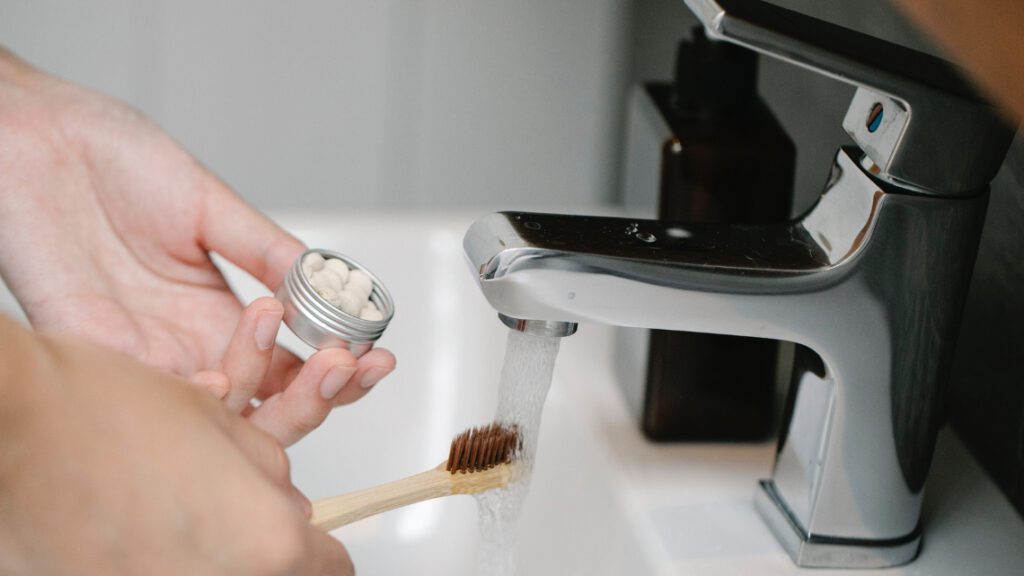
What is the difference between eco-friendly products and normal products?
The primary difference between eco-friendly products and non-eco-friendly products lies in their environmental impact and sustainability. Here’s a breakdown of the key distinctions:
1. Environmental Impact:
- Eco-Friendly Products: These products are designed and manufactured with the environment in mind. They aim to minimize environmental harm throughout their entire lifecycle, from production and use to disposal. They typically have a reduced carbon footprint, generate less pollution, and use fewer non-renewable resources.
- Non-Eco-Friendly Products: Non-eco-friendly products often have a higher negative impact on the environment. They may contribute to pollution, resource depletion, and increased greenhouse gas emissions. These products often prioritize short-term cost and convenience over long-term sustainability.
2. Materials:
- Eco-Friendly Products: They are often made from renewable, recycled, or sustainable materials. This minimizes the depletion of natural resources and encourages responsible resource management.
- Non-Eco-Friendly Products: These products may rely heavily on non-renewable resources, such as fossil fuels, or use materials that are not easily recyclable or biodegradable.
3. Production Methods:
- Eco-Friendly Products: They are typically produced using environmentally responsible methods. Manufacturers of eco-friendly products may prioritize energy efficiency, waste reduction, and ethical labor practices.
- Non-Eco-Friendly Products: Production of non-eco-friendly products may involve energy-intensive processes, wasteful practices, and potentially exploitative labor conditions.
4. Energy Efficiency:
- Eco-Friendly Products: They are often designed to be energy-efficient during use, reducing energy consumption and associated emissions. For example, LED light bulbs use less electricity than traditional incandescent bulbs.
- Non-Eco-Friendly Products: These products may be less energy-efficient, leading to higher energy bills and increased environmental impact.
5. Packaging:
- Eco-Friendly Products: Packaging for eco-friendly products is typically designed to minimize waste. It may be recyclable, compostable, or use minimal materials to reduce the overall packaging footprint.
- Non-Eco-Friendly Products: Non-eco-friendly products may come in excessive, non-recyclable, or non-biodegradable packaging, contributing to landfill waste.
6. Disposal:
- Eco-Friendly Products: These products are often biodegradable or recyclable, making them easier to dispose of in an environmentally responsible manner. They are less prone to being disposed of in landfills.
- Non-Eco-Friendly Products: Non-eco-friendly products may not break down easily, and their disposal can contribute to pollution and landfill overcrowding.
7. Chemical Composition:
- Eco-Friendly Products: They are typically formulated with non-toxic, biodegradable, and environmentally safe ingredients. This reduces exposure to harmful chemicals and minimizes water and air pollution.
- Non-Eco-Friendly Products: Non-eco-friendly products may contain hazardous chemicals that can harm both human health and the environment. For example, many traditional cleaning products contain harsh chemicals that can pollute waterways.
8. Longevity and Durability:
- Eco-Friendly Products: They often prioritize durability, reducing the need for frequent replacements. This can lead to less overall waste and resource consumption.
- Non-Eco-Friendly Products: Some non-eco-friendly products may be designed with planned obsolescence in mind, meaning they wear out or become obsolete quickly, leading to more frequent replacements.
9. Cost and Accessibility:
- Eco-Friendly Products: While they can sometimes be more expensive upfront, they often lead to cost savings over time, such as reduced energy bills or fewer replacement purchases. Accessibility to eco-friendly products may vary by location and economic factors.
- Non-Eco-Friendly Products: Non-eco-friendly products are often cheaper upfront but can be more costly in the long run when considering environmental and health impacts.
In summary, eco-friendly products are intentionally designed and produced with sustainability and minimal environmental impact in mind, whereas non-eco-friendly products prioritize convenience, cost-efficiency, and traditional manufacturing methods that may have more significant negative consequences for the environment and human health. Choosing eco-friendly products is one-way individuals and businesses can contribute to a more sustainable and environmentally responsible future.

A Comprehensive Buying Guide for Eco-Friendly Products
In a world where environmental consciousness is gaining momentum, making eco-friendly choices when shopping for products has become increasingly important. Whether you’re looking to reduce your carbon footprint, minimize waste, or support sustainable practices, this buying guide will help you make informed decisions when purchasing eco-friendly products.
1. Define Your Priorities
Before you start shopping for eco-friendly products, it’s essential to clarify your priorities. Are you looking to reduce plastic waste, lower energy consumption, or support sustainable agriculture? By understanding your objectives, you can better tailor your purchases to align with your values.
2. Research the Product
When considering an eco-friendly product, delve into its specifications and environmental impact.
Product Specifications:
- Materials: Look for products made from renewable, recycled, or sustainable materials. For instance, bamboo, organic cotton, and recycled plastics are common eco-friendly materials.
- Production Methods: Research how the product is manufactured. Eco-friendly products are often produced using energy-efficient processes and ethical labor practices.
- Packaging: Consider the packaging. Minimal, recyclable, or compostable packaging is a sign of eco-friendliness.
- Energy Efficiency: If the product requires energy, like appliances or lighting, look for energy-efficient options. For instance, LED light bulbs consume less electricity than incandescent bulbs, and Energy Star-rated appliances are designed to be more efficient.
3. Check for Certifications and Labels
Many eco-friendly products carry certifications and labels that indicate their environmental credentials. Look for these on product packaging or descriptions. Common certifications include:
- EPA Safer Choice: Indicates that a cleaning product meets environmental and health standards.
- Energy Star: Certifies energy-efficient appliances and electronics.
- Fair Trade: Guarantees fair wages and ethical labor practices.
- Organic: Ensures that agricultural products are grown without synthetic pesticides or GMOs.
- BPI (Biodegradable Products Institute): Certifies products as biodegradable and compostable.
4. Read Reviews and Expert Opinions
Consulting user reviews and expert opinions can provide valuable insights into a product’s performance and eco-friendliness. Look for reviews on e-commerce platforms, blogs, and websites dedicated to sustainable living.
5. Consider Longevity and Durability
Eco-friendly products often emphasize durability. Assess the product’s quality and how long it is likely to last. Products that require fewer replacements over time reduce waste and resource consumption.
6. Assess Costs and Savings
Eco-friendly products may have a higher upfront cost, but it’s essential to consider long-term savings. For example, LED light bulbs may be more expensive initially, but they consume less electricity, leading to lower energy bills over time.
7. Check Accessibility
The availability of eco-friendly products can vary by location and economic factors. Consider where you can purchase these products, both locally and online. Support local businesses that prioritize sustainability when possible.
8. Compare and Choose
Once you’ve collected all the relevant information, make a side-by-side comparison of the eco-friendly products you’re considering. Weigh the pros and cons, including cost, durability, and environmental impact. Select the product that aligns best with your priorities and values.
9. Dispose of Products Responsibly
Lastly, when you’re done with an eco-friendly product, ensure its proper disposal. Recycling, composting, or donating are great ways to extend a product’s life cycle and reduce waste.
As consumers, our choices have a significant impact on the environment. By following this buying guide and choosing eco-friendly products, you can contribute to a more sustainable and eco-conscious future. Your purchases play a vital role in reducing waste, conserving resources, and promoting environmentally responsible practices.

FAQ
Frequently Asked Questions (FAQ) about Eco-Friendly Products
1. What are eco-friendly products?
Eco-friendly products, also known as environmentally friendly or green products, are items designed and manufactured with the primary goal of minimizing their negative impact on the environment. They are typically produced using sustainable materials, processes, and packaging and aim to reduce energy consumption, waste, and pollution throughout their life cycle.
2. Why should I choose eco-friendly products?
Choosing eco-friendly products can have several benefits, including reducing your carbon footprint, minimizing waste, conserving natural resources, and supporting ethical and sustainable practices. It’s a way to contribute to a more environmentally responsible and sustainable future.
3. What are some common examples of eco-friendly products?
Common examples of eco-friendly products include reusable shopping bags, energy-efficient LED light bulbs, hybrid or electric cars, organic and Fair Trade-certified products, low-flow showerheads, and cleaning products made from non-toxic, biodegradable ingredients.
4. How can I identify eco-friendly products?
You can identify eco-friendly products by looking for certifications and labels on the packaging, reading product descriptions and specifications, and researching the brand’s commitment to sustainability. Certifications like Energy Star, EPA Safer Choice, Fair Trade, and organic labels are good indicators of eco-friendliness.
5. Are eco-friendly products more expensive?
Eco-friendly products can sometimes be more expensive upfront due to higher production costs and the use of sustainable materials. However, they often lead to cost savings in the long run through lower energy consumption, reduced waste, and increased product durability.
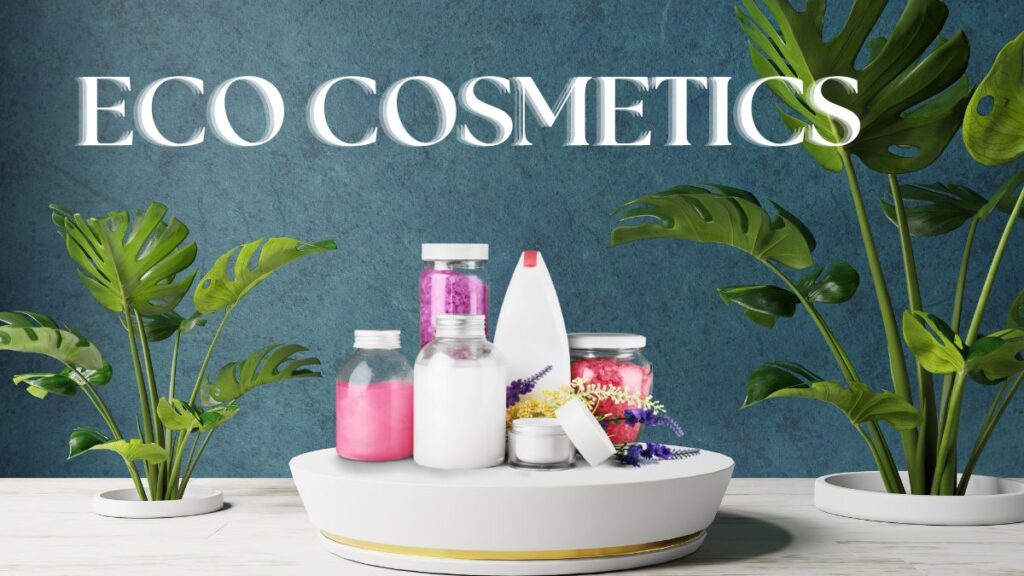
6. What is the difference between “biodegradable” and “compostable” products?
Biodegradable products can break down naturally over time, but the process may not always be environmentally friendly. Compostable products, on the other hand, are designed to break down into natural, non-toxic components when placed in a composting environment, making them a more sustainable option.
7. Are there eco-friendly alternatives for everyday products?
Yes, there are eco-friendly alternatives to many everyday products. For example, you can replace single-use plastic bottles with reusable stainless steel water bottles, or traditional cleaning products with eco-friendly, non-toxic options.
8. How do I properly dispose of eco-friendly products?
The disposal of eco-friendly products depends on the specific product and its materials. Generally, you should follow local recycling and waste management guidelines. Some products, like compostable tableware, can be composted, while others, like electronic waste, may need to be taken to specialized recycling centers.
9. Where can I find eco-friendly products for purchase?
Eco-friendly products are available in various places, including local stores, online retailers, and specialty eco-conscious boutiques. Many well-known brands also offer eco-friendly product lines.
10. How can I make eco-friendly choices when shopping for products?
To make eco-friendly choices, define your priorities, research products, check for certifications, read reviews, consider costs and savings, and assess a product’s longevity and durability. By following these steps and choosing products that align with your values, you can make more sustainable purchasing decisions.

Conclusion:
Embracing eco-friendly products is a crucial step towards a more sustainable and greener future. By choosing products like reusable straws, beeswax food wraps, solar-powered chargers, and others mentioned in this article, you can significantly reduce your environmental footprint. These products offer not only immediate benefits, such as saving money and reducing waste but also contribute to the long-term health of our planet. It’s time to make the shift towards sustainability and invest in a better future for generations to come.
You can see Best 20 Home Decor Products. Maybe you like it. Products detailed Here

The details of The Best 11 Eco-Friendly Products are given below:
1. Reusable Stainless Steel Straws
Product Specification:
- Material: Food-grade stainless steel
- Length: Standard (8.5 inches) or extra-long (10.5 inches)
- Cleaning: Dishwasher safe
- The set includes: Straws, cleaning brushes, and a carry-case
Product Description:
Reusable stainless steel straws are a fantastic alternative to single-use plastic straws. They are durable, easy to clean, and come in various lengths and designs to suit your preferences. The included carry case makes it convenient to carry them on the go.
Pros:
- Reusable, reducing plastic waste
- Long-lasting and durable
- Dishwasher safe for easy cleaning
Cons:
- Some people dislike the metal taste
- Can get hot or cold to the touch, depending on the beverage
Expert Opinion:
“Stainless steel straws are a simple yet impactful switch to reduce plastic pollution. They are sturdy, easy to maintain, and make for a stylish addition to your eco-friendly toolkit.” – Sarah Green, Environmental Scientist
2. Beeswax Food Wraps
Product Specification:
- Material: Organic cotton infused with beeswax, resin, and jojoba oil
- Sizes: Various (small, medium, large)
- Reusability: Up to 12 months
- Cleaning: Hand wash with mild soap and cold water cleaning.
Product Description:
Beeswax food wraps are an eco-friendly alternative to plastic wraps. They’re made from organic materials and are reusable for up to a year. The warmth from your hands makes them malleable, allowing you to wrap food items of all shapes and sizes securely.
Pros:
- Reduces plastic use and waste
- Breathable and helps preserve food freshness
- Versatile and customizable
Cons:
- Not suitable for hot foods or microwaving
- May must regular re-waxing
Expert Opinion:
“Beeswax wraps are a sustainable way to keep your food fresh. while eliminating the need for disposable plastic wrap. They are also a great conversation starter to raise awareness about reducing plastic usage.” – Dr. Emily Green, Environmental Biologist

3. Solar-powered phone Charger
Product Specification:
- Charging capacity: Varies by model
- Charging ports: Many USB ports
- Battery: Lithium-polymer or lithium-ion
- Weight and size: Varies by model
Product Description:
A solar-powered phone charger harnesses the power of the sun to charge your devices. They are perfect for outdoor enthusiasts, and travelers. or anyone looking to reduce their reliance on traditional power sources. Some models even have built-in batteries for continuous charging at night.
Pros:
- Renewable energy source
- Ideal for camping and outdoor activities
- Emergency power source
Cons:
- Charging time can be slower on cloudy days
- The initial investment may be higher
Expert Opinion:
“Solar-powered phone chargers are a brilliant way to stay connected in remote areas while minimizing your carbon footprint. They are an essential tool for modern, eco-conscious adventurers.” – Dr. Robert Miller, Renewable Energy Specialist
4. Colgate Charcoal Bamboo Toothbrushes
Product Specification:
- Bristle material: Nylon-6 or bamboo charcoal-infused bristles
- Handle material: Sustainable bamboo
- Bristle options: Soft, medium, or firm
- Packaging: Compostable or recyclable
Product Description:
Colgate Charcoal Bamboo toothbrushes offer a sustainable alternative to traditional plastic toothbrushes. The bamboo handles are biodegradable, and some models feature eco-friendly bristles. These brushes come in various bristle options to suit your dental hygiene needs.
Pros:
- Biodegradable handle reduces plastic waste
- Natural, antibacterial properties of bamboo
- Many bristle options for user preference
Cons:
- Bristles may not be fully biodegradable
- The durability of bristles may vary
Expert Opinion:
“Bamboo toothbrushes are a small but significant step towards reducing plastic pollution. By making this simple switch, you can make a big contribution to a cleaner environment.” – Dr. Lisa Chen, Dentist and Environmental Advocate

Colgate Charcoal Bamboo toothbrushes
5. Eco-Friendly Products Laundry Detergent
Product Specification:
- Form: Liquid, powder, or pods
- Scent: Various options
- Packaging: Recyclable or biodegradable
- Special features: Hypoallergenic, plant-based, or free of harmful chemicals
Product Description:
Eco-friendly laundry detergents are designed to clean your clothes effectively. while minimizing their impact on the environment. They often use plant-based ingredients and avoid harsh chemicals. and come in sustainable packaging options.
Pros:
- Reduces water pollution and chemical exposure
- Gentle on sensitive skin
- Cruelty-free and ethical production
Cons:
- May be slightly more expensive than conventional detergents
- Some formulas might not perform as well on tough stains
Expert Opinion:
“Switching to eco-friendly laundry detergents is an easy way to protect both your family’s health and the environment. The long-term benefits outweigh any slight increase in cost.” – Emma White, Environmental Chemist

Eco-Friendly Laundry Detergent
6. LED Light Bulbs
Product Specification:
- Type: Various options (A19, BR30, etc.)
- Wattage: Varies by the model (typically 5-15W)
- Color temperature: Warm, cool, or daylight
- Lifespan: Up to 25,000 hours
Product Description:
LED (Light Emitting Diode) bulbs are energy-efficient lighting solutions. They consume less electricity than incandescent or fluorescent bulbs and have a longer lifespan. LED bulbs come in various shapes and sizes to fit different fixtures.
Pros:
- Energy-efficient, reducing electricity consumption
- Long lifespan saves money on replacements
- Instant-on and dimmable options
Cons:
- Higher initial cost compared to incandescent bulbs
- May not fit some specialty fixtures
Expert Opinion:
“LED bulbs are the future of lighting. They offer not only energy savings but also versatility and longevity. Making them an excellent choice for homeowners looking to reduce their carbon footprint.” – David Smith, Lighting Specialist
7. Reusable Shopping Bags
Product Specification:
- Material: Durable fabric (e.g., canvas, jute, or recycled plastics)
- Size: Varies (small, medium, large)
- Weight capacity: Typically 10-20 lbs
- Handles: Short or long, with or without reinforcement
Product Description:
Reusable shopping bags provide an environmentally responsible substitute for disposable plastic bags. They are sturdy, washable, and come in various sizes and designs. Many retailers offer discounts for bringing your bags, making them both environmentally and economically friendly.
Pros:
- Reduces plastic bag pollution
- Durable and long-lasting
- Economical with store discounts
Cons:
- Remembering to bring them can be a challenge
- The initial investment may be required
Expert Opinion:
“Reusable shopping bags are an easy and effective way to reduce plastic waste. They’re also a visible reminder of our commitment to sustainability, encouraging others to follow suit.” – Dr. Maria Rodriguez, Environmental Psychologist

8. Hybrid or Electric Cars
Product Specification:
- Model options: Various, such as Toyota Prius, Tesla Model 3, Nissan Leaf
- Electric range: Varies by the model (typically 100-300 miles)
- Fuel efficiency: Measured in miles per gallon equal (MPGe)
- Charging time: Varies (30 minutes to overnight)
Product Description:
Hybrid and electric cars are eco-friendly transportation options designed to reduce greenhouse gas emissions and decrease reliance on fossil fuels. Hybrids combine electric and gasoline power. while electric vehicles run solely on electricity, producing zero tailpipe emissions.
Pros:
- Drastically reduces carbon emissions
- Lower operating costs (less fuel, fewer maintenance needs)
- Incentives and tax credits may be available
Cons:
- Higher upfront cost compared to traditional vehicles
- Limited charging infrastructure in some areas
Expert Opinion:
“Adopting hybrid or electric vehicles is vital in the fight against climate change. These cars offer a practical solution to reducing carbon emissions. without sacrificing performance and convenience.” – Dr. John Harris, Environmental Economist
9. Compostable Tableware
Product Specification:
- Material: Various, including cornstarch, sugarcane, or bamboo
- Types: Plates, utensils, cups, and more
- Certifications: ASTM D6400, BPI, or other compostability standards
- Durability: Varies by material
Product Description:
Compostable tableware provides an eco-friendly alternative to single-use plastic or paper products. They are made from renewable resources, are biodegradable, and can be composted along with food waste.
Pros:
- Reduces plastic and paper waste
- Made from renewable materials
- Suitable for both home and commercial use
Cons:
- Durability varies by material and brand
- May be slightly more expensive than traditional tableware
Expert Opinion:
“Compostable tableware is an excellent solution for reducing waste at events and gatherings. When disposed of properly, it can return nutrients to the soil rather than contributing to landfill pollution.” – Dr. Lisa Patel, Environmental Scientist

Compostable tableware
10. Low-Flow Showerheads
Product Specification:
- Flow rate: Typically 1.5-2.0 gallons per minute (GPM)
- Materials: Various (e.g., chrome-plated brass, plastic)
- Installation: Standard or hand-held options
- Water-saving features: Aerated spray, adjustable flow
Product Description:
Low-flow showerheads are designed to reduce water consumption. while maintaining a satisfying shower experience. They can save both water and energy, as less hot water is needed, resulting in lower utility bills and reduced carbon emissions.
Pros:
- Significant water and energy savings
- Easy installation in most bathrooms
- Various styles and features are available
Cons:
- Some users may find lower water pressure less satisfying
- Initial investment may be required
Expert Opinion:
“Low-flow showerheads are a win-win solution. They save water and energy, reducing utility bills. and environmental impact without compromising on comfort.” – Sarah Adams, Water Efficiency Specialist
11. Eco-Friendly Cleaning Products
Product Specification:
- Type: All-purpose cleaner, dish soap, laundry detergent, etc.
- Ingredients: Plant-based, biodegradable, non-toxic
- Packaging: Recyclable or refillable options
- Certifications: EPA Safer Choice, Green Seal, or similar
Product Description:
Eco-friendly cleaning products offer a sustainable alternative to traditional cleaning supplies. They are formulated with plant-based, biodegradable ingredients and avoid harmful chemicals. Many come in recyclable or refillable packaging, reducing plastic waste.
Pros:
- Non-toxic and safer for households with children and pets
- Reduces indoor air pollution and chemical exposure
- Eco-friendly packaging options
Cons:
- May be slightly more expensive than conventional cleaners
- Some formulations may not be as effective on tough stains
Expert Opinion:
“Utilizing friendly cleaning products is imperative for keeping a pristine home while preserving the environment. Making this switch is a smart and conscious choice for both your family’s health and the planet.” – Dr. Lisa Turner, Environmental Health Specialist

What is the difference between eco-friendly products and normal products?
The primary difference between eco-friendly products and non-eco-friendly products lies in their environmental impact and sustainability. Here’s a breakdown of the key distinctions:
1. Environmental Impact:
- Eco-Friendly Products: These products are designed and manufactured with the environment in mind. They aim to minimize environmental harm throughout their entire lifecycle, from production and use to disposal. They typically have a reduced carbon footprint, generate less pollution, and use fewer non-renewable resources.
- Non-Eco-Friendly Products: Non-eco-friendly products often have a higher negative impact on the environment. They may contribute to pollution, resource depletion, and increased greenhouse gas emissions. These products often prioritize short-term cost and convenience over long-term sustainability.
2. Materials:
- Eco-Friendly Products: They are often made from renewable, recycled, or sustainable materials. This minimizes the depletion of natural resources and encourages responsible resource management.
- Non-Eco-Friendly Products: These products may rely heavily on non-renewable resources, such as fossil fuels, or use materials that are not easily recyclable or biodegradable.
3. Production Methods:
- Eco-Friendly Products: They are typically produced using environmentally responsible methods. Manufacturers of eco-friendly products may prioritize energy efficiency, waste reduction, and ethical labor practices.
- Non-Eco-Friendly Products: Production of non-eco-friendly products may involve energy-intensive processes, wasteful practices, and potentially exploitative labor conditions.
4. Energy Efficiency:
- Eco-Friendly Products: They are often designed to be energy-efficient during use, reducing energy consumption and associated emissions. For example, LED light bulbs use less electricity than traditional incandescent bulbs.
- Non-Eco-Friendly Products: These products may be less energy-efficient, leading to higher energy bills and increased environmental impact.
5. Packaging:
- Eco-Friendly Products: Packaging for eco-friendly products is typically designed to minimize waste. It may be recyclable, compostable, or use minimal materials to reduce the overall packaging footprint.
- Non-Eco-Friendly Products: Non-eco-friendly products may come in excessive, non-recyclable, or non-biodegradable packaging, contributing to landfill waste.
6. Disposal:
- Eco-Friendly Products: These products are often biodegradable or recyclable, making them easier to dispose of in an environmentally responsible manner. They are less prone to being disposed of in landfills.
- Non-Eco-Friendly Products: Non-eco-friendly products may not break down easily, and their disposal can contribute to pollution and landfill overcrowding.
7. Chemical Composition:
- Eco-Friendly Products: They are typically formulated with non-toxic, biodegradable, and environmentally safe ingredients. This reduces exposure to harmful chemicals and minimizes water and air pollution.
- Non-Eco-Friendly Products: Non-eco-friendly products may contain hazardous chemicals that can harm both human health and the environment. For example, many traditional cleaning products contain harsh chemicals that can pollute waterways.
8. Longevity and Durability:
- Eco-Friendly Products: They often prioritize durability, reducing the need for frequent replacements. This can lead to less overall waste and resource consumption.
- Non-Eco-Friendly Products: Some non-eco-friendly products may be designed with planned obsolescence in mind, meaning they wear out or become obsolete quickly, leading to more frequent replacements.
9. Cost and Accessibility:
- Eco-Friendly Products: While they can sometimes be more expensive upfront, they often lead to cost savings over time, such as reduced energy bills or fewer replacement purchases. Accessibility to eco-friendly products may vary by location and economic factors.
- Non-Eco-Friendly Products: Non-eco-friendly products are often cheaper upfront but can be more costly in the long run when considering environmental and health impacts.
In summary, eco-friendly products are intentionally designed and produced with sustainability and minimal environmental impact in mind, whereas non-eco-friendly products prioritize convenience, cost-efficiency, and traditional manufacturing methods that may have more significant negative consequences for the environment and human health. Choosing eco-friendly products is one-way individuals and businesses can contribute to a more sustainable and environmentally responsible future.

A Comprehensive Buying Guide for Eco-Friendly Products
In a world where environmental consciousness is gaining momentum, making eco-friendly choices when shopping for products has become increasingly important. Whether you’re looking to reduce your carbon footprint, minimize waste, or support sustainable practices, this buying guide will help you make informed decisions when purchasing eco-friendly products.
1. Define Your Priorities
Before you start shopping for eco-friendly products, it’s essential to clarify your priorities. Are you looking to reduce plastic waste, lower energy consumption, or support sustainable agriculture? By understanding your objectives, you can better tailor your purchases to align with your values.
2. Research the Product
When considering an eco-friendly product, delve into its specifications and environmental impact.
Product Specifications:
- Materials: Look for products made from renewable, recycled, or sustainable materials. For instance, bamboo, organic cotton, and recycled plastics are common eco-friendly materials.
- Production Methods: Research how the product is manufactured. Eco-friendly products are often produced using energy-efficient processes and ethical labor practices.
- Packaging: Consider the packaging. Minimal, recyclable, or compostable packaging is a sign of eco-friendliness.
- Energy Efficiency: If the product requires energy, like appliances or lighting, look for energy-efficient options. For instance, LED light bulbs consume less electricity than incandescent bulbs, and Energy Star-rated appliances are designed to be more efficient.
3. Check for Certifications and Labels
Many eco-friendly products carry certifications and labels that indicate their environmental credentials. Look for these on product packaging or descriptions. Common certifications include:
- EPA Safer Choice: Indicates that a cleaning product meets environmental and health standards.
- Energy Star: Certifies energy-efficient appliances and electronics.
- Fair Trade: Guarantees fair wages and ethical labor practices.
- Organic: Ensures that agricultural products are grown without synthetic pesticides or GMOs.
- BPI (Biodegradable Products Institute): Certifies products as biodegradable and compostable.
4. Read Reviews and Expert Opinions
Consulting user reviews and expert opinions can provide valuable insights into a product’s performance and eco-friendliness. Look for reviews on e-commerce platforms, blogs, and websites dedicated to sustainable living.
5. Consider Longevity and Durability
Eco-friendly products often emphasize durability. Assess the product’s quality and how long it is likely to last. Products that require fewer replacements over time reduce waste and resource consumption.
6. Assess Costs and Savings
Eco-friendly products may have a higher upfront cost, but it’s essential to consider long-term savings. For example, LED light bulbs may be more expensive initially, but they consume less electricity, leading to lower energy bills over time.
7. Check Accessibility
The availability of eco-friendly products can vary by location and economic factors. Consider where you can purchase these products, both locally and online. Support local businesses that prioritize sustainability when possible.
8. Compare and Choose
Once you’ve collected all the relevant information, make a side-by-side comparison of the eco-friendly products you’re considering. Weigh the pros and cons, including cost, durability, and environmental impact. Select the product that aligns best with your priorities and values.
9. Dispose of Products Responsibly
Lastly, when you’re done with an eco-friendly product, ensure its proper disposal. Recycling, composting, or donating are great ways to extend a product’s life cycle and reduce waste.
As consumers, our choices have a significant impact on the environment. By following this buying guide and choosing eco-friendly products, you can contribute to a more sustainable and eco-conscious future. Your purchases play a vital role in reducing waste, conserving resources, and promoting environmentally responsible practices.

FAQ
Frequently Asked Questions (FAQ) about Eco-Friendly Products
1. What are eco-friendly products?
Eco-friendly products, also known as environmentally friendly or green products, are items designed and manufactured with the primary goal of minimizing their negative impact on the environment. They are typically produced using sustainable materials, processes, and packaging and aim to reduce energy consumption, waste, and pollution throughout their life cycle.
2. Why should I choose eco-friendly products?
Choosing eco-friendly products can have several benefits, including reducing your carbon footprint, minimizing waste, conserving natural resources, and supporting ethical and sustainable practices. It’s a way to contribute to a more environmentally responsible and sustainable future.
3. What are some common examples of eco-friendly products?
Common examples of eco-friendly products include reusable shopping bags, energy-efficient LED light bulbs, hybrid or electric cars, organic and Fair Trade-certified products, low-flow showerheads, and cleaning products made from non-toxic, biodegradable ingredients.
4. How can I identify eco-friendly products?
You can identify eco-friendly products by looking for certifications and labels on the packaging, reading product descriptions and specifications, and researching the brand’s commitment to sustainability. Certifications like Energy Star, EPA Safer Choice, Fair Trade, and organic labels are good indicators of eco-friendliness.
5. Are eco-friendly products more expensive?
Eco-friendly products can sometimes be more expensive upfront due to higher production costs and the use of sustainable materials. However, they often lead to cost savings in the long run through lower energy consumption, reduced waste, and increased product durability.

6. What is the difference between “biodegradable” and “compostable” products?
Biodegradable products can break down naturally over time, but the process may not always be environmentally friendly. Compostable products, on the other hand, are designed to break down into natural, non-toxic components when placed in a composting environment, making them a more sustainable option.
7. Are there eco-friendly alternatives for everyday products?
Yes, there are eco-friendly alternatives to many everyday products. For example, you can replace single-use plastic bottles with reusable stainless steel water bottles, or traditional cleaning products with eco-friendly, non-toxic options.
8. How do I properly dispose of eco-friendly products?
The disposal of eco-friendly products depends on the specific product and its materials. Generally, you should follow local recycling and waste management guidelines. Some products, like compostable tableware, can be composted, while others, like electronic waste, may need to be taken to specialized recycling centers.
9. Where can I find eco-friendly products for purchase?
Eco-friendly products are available in various places, including local stores, online retailers, and specialty eco-conscious boutiques. Many well-known brands also offer eco-friendly product lines.
10. How can I make eco-friendly choices when shopping for products?
To make eco-friendly choices, define your priorities, research products, check for certifications, read reviews, consider costs and savings, and assess a product’s longevity and durability. By following these steps and choosing products that align with your values, you can make more sustainable purchasing decisions.

Conclusion:
Embracing eco-friendly products is a crucial step towards a more sustainable and greener future. By choosing products like reusable straws, beeswax food wraps, solar-powered chargers, and others mentioned in this article, you can significantly reduce your environmental footprint. These products offer not only immediate benefits, such as saving money and reducing waste but also contribute to the long-term health of our planet. It’s time to make the shift towards sustainability and invest in a better future for generations to come.
You can see Best 20 Home Decor Products. Maybe you like it. Products detailed Here



